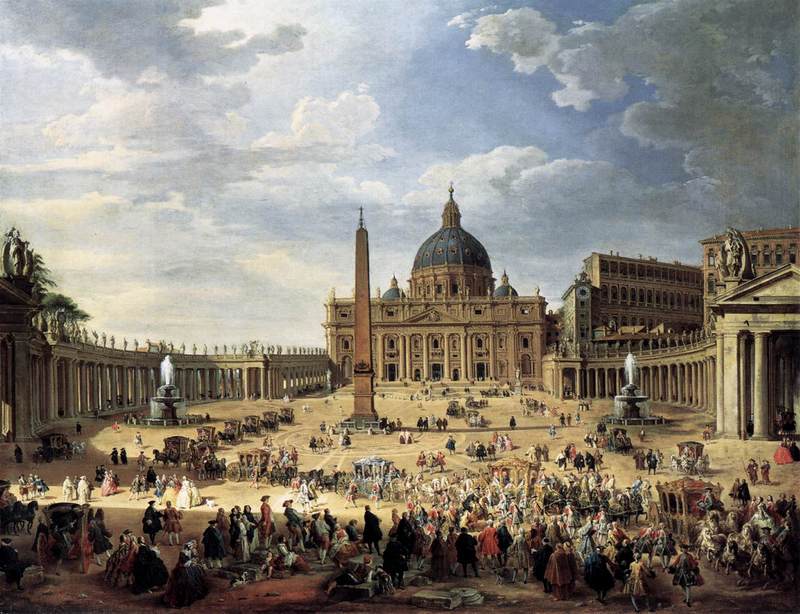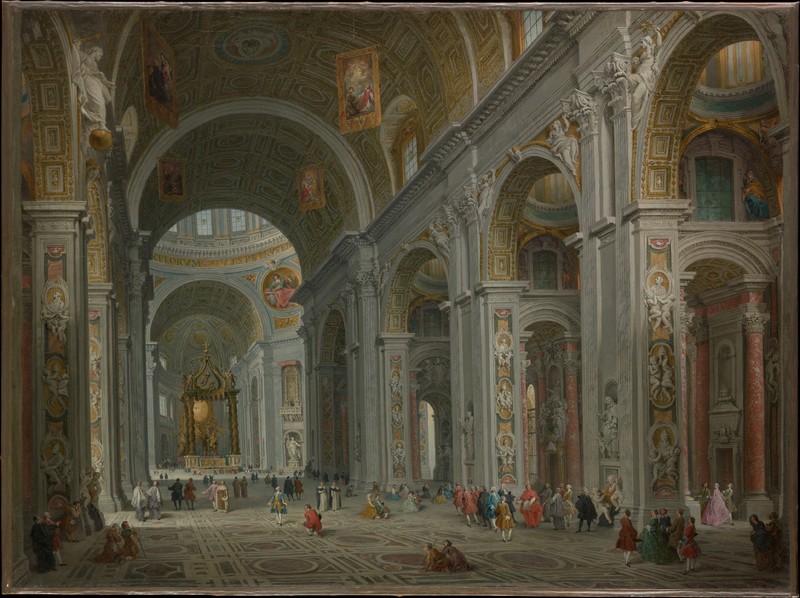Views of Modern Rome
In the earlier part of his career, Giovanni Paolo Panini, though a painter, was considered to be working within the field of architecture because of his attention to minute detail, accuracy and faithfulness to perspective.[1] Panini only began to produce the vedute to which he owes his fame in the last thirty years of his life, a consequence of the high demand for such works stemming from the fashion at the time of the Grand Tour.[2] His views, a form of urban landscape intended to capture the beauty and romance of the Italian vistas endemic to the Grand Tour, generally divide into two genres, vedute reale and vedute ideate.[3]
Within the larger category of vedute, Panini was famous for his quadri di cerimonia, paintings celebrating an event or ceremony.[4] It is in this subcategory that Panini achieved a considerable patronage and received many commissions, most notable among them from the Duc de Choiseul, a French nobleman, who at the time was serving as Ambassador to the Vatican for Louis XV, and Cardinal Melchior de Polignac (1661-1742), another French nobleman of high rank in the service of Louis XV.[5] Panini’s “modern views”, consisting of views of monuments constructed in the Renaissance and Baroque period as opposed to antiquity, emerge to prominence within this context. Of particular importance, Panini’s Departure of the Duc de Choiseul from the Piazza di San Pietro and Interior of Saint Peter's offer two intriguingly diametric perspectives of the same architectural masterpiece of the Grand Tour. The first painting portrays an exterior view of Saint Peter’s as part of the landscape of the quintessentially Italian piazza, while the later unveils the secrets of the interior, exploring the magnitude and majesty inside its doors. What becomes apparent from these works is that, in addition to satisfying the demands of his patrons, Panini was responding to the artistic tendencies of the time and feeding off of his contemporaries for inspiration. In particular, a comparison can be drawn between Panini’s Preparations to Celebrate the Birth of Dauphin of France in 1729 in Piazza Navona, and works by his contemporary, Canaletto (1697-1768), who was also interested in vedutismo and the panoramic view.

Giovanni Paolo Panini, Departure of the Duc de Choiseul from the Piazza di San Pietro, 1754, oil on canvas (Staatliche Museen, Berlin)
Departure of the Duc de Choiseul from the Piazza di San Pietro is an oil on canvas completed in 1754, measuring 152 cm x 195 cm, currently housed in the Staatliche Museum in Berlin. The work is one in a series of five ordered by the Duc de Choiseul, and documents the scene following the Duke’s first audience with Pope Benedict XIV. The laboriously executed painting features a highly detailed wide view of the entire Piazza di San Pietro, and shows the long procession of carriages following behind the gilded carriage of the Duc de Choiseul. This painting can be considered a quadro di ceremonia, as it documents in detail an important ceremonial event of the time. Half of the composition is sky, and Panini has chosen to represent the event on a seemingly cloudy day, with sunshine projecting from the upper left corner, offering an aura of romanticism and mystery, as if the scene had been pierced by heavenly light. The foreground depicts a bustling crowd of people, significantly larger in scale than the people partaking in the procession as a way of rendering depth and perspective, for which Panini was renowned.[6] Predominately in shadow, these first figures, visible at the base of the painting, appear to be crowding around the Duke’s carriage as it approaches, evoking an ambiance of excitement. The painting extends far back into the vista, however, and includes the entire colonnade surrounding the piazza and even the papal apartments on the far right. Panini was renowned for his mastery of perspective and his ability to capture perfectly the architecture of a place. The size of the figures in the composition conveys this sense of depth; as the viewer’s eye moves deeper into the painting, the figures, nonetheless individualized, become little more than minute brush strokes. In addition, the entire composition gives a sense of motion consistent with the architecture of the piazza; the procession of carriages in the painting pays tribute to the circular nature of the piazza. The viewer can imagine a scene made up of many rings (like the circles inside a tree trunk) that grow smaller and smaller as they approach the center of the piazza, which is firmly demarcated by a majestic obelisk, pointing to the sky. As this painting illustrates, Panini’s vedute weave a seamless web between a fundamental understanding of architecture and an ability to capture the essence of a place and its living splendor.

Giovanni Paolo Panini, Interior of Saint Peter's, after 1754, oil on canvas (Metropolitan Museum of Art)
The Interior of Saint Peter, completed after 1754, around the time Panini completed the Departure of the Duc de Choiseul, depicts a very different kind of veduta. In this oil on canvas the viewer is guided through the monumental interior of Saint Peter’s, leading up to the famous Bernini baldacchino. The painting presents towering archways and miniature people. Set at a slight angle the composition shows more of the right side of the interior. Though the focal point is the gold altar in the background, the viewer’s eye continues to travel past the altar; in this way Panini provides a complete view of the entire interior. The painting measures 74 cm x 99.7 cm, and is one of many Panini renditions of this interior, the earliest painted for Cardinal Melchior de Polignac, dating back to 1730 and part of the collection at the Louvre.[7] While all of the versions appear very similar at first glance, upon further inspection the viewer notices alterations that coincide with changes inside the Basilica at the time Panini was working on the painting. Sunlight seeps through a window on the upper left corner of the composition, creating shadows in its wake, evoking a vibrant sense of immediacy and bringing the scene to life. Panini, once again is careful to depict the view as accurately as possible, reproducing with exactitude the architectural flourishes that adorn the walls and ornate gilded ceiling, the elaborate design of the floors, and indeed going so far as to reproduce to scale replicas of the paintings hanging from the rafters and masterworks adorning the upper arches. He thus dedicates enormous effort and attention to faithfully rendering the monumental interior as it would have been seen at the time of the painting’s completion. Prior to the Interior of Saint Peter, 1754 marked the addition of two new statues in the niches of the main nave commissioned by Pope Benedict XIV, namely a statue of Saint Theresa of Avila, and Saint Vincent de Paul.[8] These statues appear in the niches on the first two pilasters on the right side. Thus, Panini’s work serves not only as a memento for the visiting tourist, but as an historical document that chronicles the progression of changes made in the Basilica.

Giovanni Paolo Panini, Preparations to Celebrate the Birth of Dauphin of France in 1729 in Piazza Navona, 1729, oil on canvas (Musée du Louvre, Paris)
Similar to the Departure of the Duc de Choiseul, Preparations to Celebrate the Birth of Dauphin of France in 1729 in Piazza Navona, from 1729, can be characterized as one of Panini’s many “quadri di cerimonia”. Bowron’s description of Panini as “Rome’s pictorial chronicler par excellence” is irrefutably reflected in this ornate and elaborate panoramic view of Piazza Navona.[9] The painting celebrates the birth of Louis XV’s son. In honor of the newborn prince, the Holy See planned ten days of celebration, which Cardinal Melchior de Polignac commissioned Panini to record for posterity.[10] The oil on canvas, measuring 107 cm x 248 cm, depicts a horizontal view of Piazza Navona buzzing with excitement. The panoramic composition is divided into two horizontal planes; the foreground is occupied by colorful, fashionably dressed crowds of people—once again depicted almost as miniatures—while in the center of the two planes Panini places the iconic Romanesque and Baroque statues and fountains of Piazza Navona. In the far background architecturally accurate buildings line the back row of the composition; the rest of the canvas is a sultry grayish blue sky filled with clouds. As in the previously discussed works, Panini again uses the effect of natural light to bring the painting to life; a long shadow cast by overhead clouds falls over the lower left side of the composition and evokes a feeling of late afternoon and the approaching hour of the fireworks event.
Among Panini’s contemporaries, Canaletto, was also renowned for his work on behalf of patrons from the Grand Tour, particularly in Venice. A meaningful comparison can be drawn between Canaletto’s work and the Piazza Navona, since both experiment with the panoramic view. These long horizontal works enabled the artist to capture a wide range of scenery, and thus provide a more complete view. As Panini did with his views of Saint Peter’s, artists of the Grand Tour characteristically manipulated the space so as to present as much as possible, and exalt place over the individual by emphasizing the grandeur of the landscape, while minimizing the people who populate it. Indeed, in so doing these artists accurately portray a sense of the Grand Tour itself and how a place would have looked if one were observing from afar; individuals appear small and insignificant compared to the monuments and architectural wonders they have traveled to see. The compositions have an uncanny way of conveying the wonder of the beholder; the figures in the composition serve to give a sense of what it must have felt like upon seeing these famous Italian sites.
[1] Ferdinando Arisi, Gian Paolo Panini (Soncino, Italy: Edizioni dei Soncino, 1991), 10.
[2] Edgar Peters Bowron et al., eds., Art in Rome in the Eighteenth Century (London : Merrell ; Philadelphia: In association with Philadelphia Museum of Art, 2000), 417.
[3] Ferdinando. Arisi, Gian Paolo Panini E I Fasti Della Roma del’700, Gian Paolo Panini (Roma: U. Bozzi, 1986), 174.
[4] Bowron et al., Art in Rome in the Eighteenth Century, 417.
[5] Ibid., 417–418.
[9] Ibid., 417.
[10] Ibid., 418.